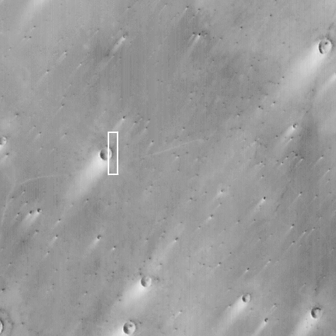
Mars Global Surveyor
Mars Orbiter Camera
Detail of an Impact Crater, Acidalia Planitia
MGS MOC Release No. MOC2-163, 19 July 1999


This pair of Mars Global Surveyor (MGS) Mars Orbiter Camera (MOC)
images shows the eastern third of a 4 kilometer-diameter impact crater
located in Acidalia Planitia. The picture on the left is a MOC red
wide angle camera context frame. It was taken at the same time as the
narrow angle (i.e., high-resolution) camera image (right).
Impact craters form by the sudden release of energy when an asteroid
slams into a planet's surface at many miles per second. The high
resolution MOC view (right) shows the walls, raised rim, and ejecta
material thrown out of the crater during this blast. Similar features
are seen at the famous Meteor Crater in northern Arizona,
U.S.A.--except that this martian example is about 4 times larger than
the one in North America. In this example, faint radial and
concentric ridges and cracks in the crater ejecta are believed to
arise from the motion of ejected material in a manner similar to thick
pancake batter flowing across the surface.
The wide angle view (left) shows that many of the craters in Acidalia
Planitia have a bright streak formed by wind transport of dust or sand.
The narrow angle image (right) covers the full field of view of the MOC
narrow angle camera--i.e., an area that is 3 kilometers (1.9 miles)
wide. Both images are illuminated from the left/lower left. The images
were acquired on July 15, 1999. The crater
is located at 34.3°N latitude, 42.9°W longitude.
Malin Space Science Systems and the California Institute of Technology
built the MOC using spare hardware from the Mars Observer mission. MSSS
operates the camera from its facilities in San Diego, CA. The Jet Propulsion
Laboratory's Mars Surveyor Operations Project operates the Mars Global Surveyor
spacecraft with its industrial partner, Lockheed Martin Astronautics, from
facilities in Pasadena, CA and Denver, CO.
 To MSSS Home Page
To MSSS Home Page
Contact: info@msss.com

